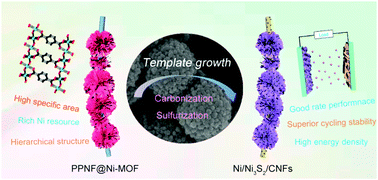Metal–organic framework derived hierarchical Ni/Ni3S2 decorated carbon nanofibers for high-performance supercapacitors†
Abstract
Metal–organic frameworks (MOFs) and their derivatives have emerged as promising electrode materials in the energy conversion and storage field in the past few years. Herein, hierarchical Ni/Ni3S2 decorated carbon nanofibers (CNFs) have been fabricated based on the template growth of MOFs on pre-oxidized electrospun polyacrylonitrile (PAN) nanofibers followed by carbonization and sulfurization processes. The formation of Ni and CNFs provides high conductivity, while the hierarchical structure contributes to a large number of exposed redox active sites. Thus the optimized hierarchical Ni/Ni3S2/CNFs achieve a high electrochemical performance as supercapacitor electrodes, exhibiting a specific capacitance of 830.0 F g−1 at 0.2 A g−1 and ideal rate capabilities. In addition, the assembled solid-state supercapacitor delivers a high energy density of 31.6 W h kg−1 at a power density of 1800 W kg−1 and a good capacitance retention of 95.7% after 5000 charge–discharge cycles. This strategy provides a basis for the efficient construction of MOF-derived electrode materials for their application in energy storage systems.



 Please wait while we load your content...
Please wait while we load your content...